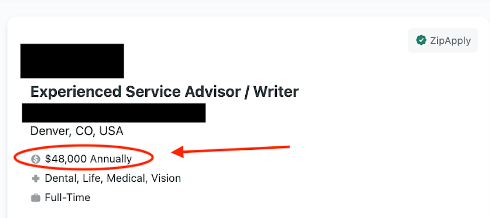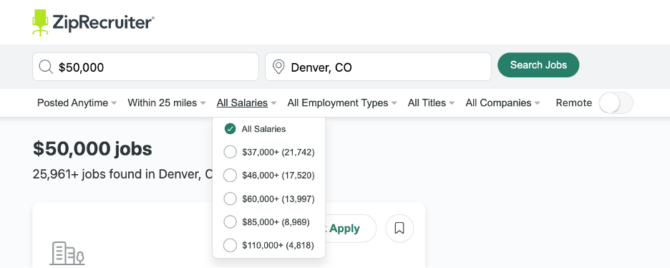
Salary Information in Job Listings: Why Include it if it’s Not Mandatory?
Traditional wisdom holds that employers shouldn’t include a salary in job listings. The thinking: not disclosing salary gives employers more power to negotiate and keeps them from overpaying a candidate who would be happy with less.
But we’re in an unconventional – and competitive – job market. Choosing not to include salary information actually limits traffic to employers’ job board listings, increasing the time it takes to fill positions.
For this reason, and also as more cities and states introduce salary disclosure mandates, now is the time to add salary information to job listings. Here’s why.
Employers Should Include Salary Data Because Job Seekers Want It (Yes, Really)
That’s right, employers should disclose salaries because it’s precisely what candidates want.
Sixty percent of candidates view salary as the most important consideration when looking for a job. And younger generations particularly value salary transparency – more than 40 percent of Gen Z and Millennial workers shared salary information with coworkers, according to a 2022 survey.
If an employer doesn’t include salary information, job seekers can find it elsewhere. That’s why sites like Glassdoor and Comparably (recently purchased by ZoomInfo) are so popular; they publicize reviews and compensation ranges. Choosing not to disclose salary just adds an extra – and unnecessary – step for applicants.
In a competitive labor market, simplifying the application process and giving candidates the information they want helps employers’ listings stand out. For their part, job boards can make it easier for employers by using tags that highlight salary at the top of a listing.
Featuring Salary Information Improves Organizational Equity
Keeping salaries hidden disadvantages BIPOC and women.
A 2021 report shows Black employees make 30 percent less than their white counterparts. The most recent data from the BLS shows that women also make 30 percent less on average than men. And this pay gap widens when comparing white men to Black women, who make just 63 cents for every dollar a white man earns.
Sharing salaries helps ensure any candidate who applies to work at a company will earn the salary they deserve. It also goes a long way in establishing the equitable and diverse culture that attracts so many job seekers today.
This equity doesn’t just attract prospective employees to businesses; it helps with retention and improves employers’ ability to generate innovative ideas. Plus, diverse companies routinely drive more profit and create better products than their homogeneous competitors.
Salary Disclosure: Where it’s Required and What it Looks Like
Sure, featuring salary information helps set companies apart, but some employers are legally required to share it because of where they’re based. While Colorado is the only state that mandates salary disclosure in job listings today, many other cities and states require employers to provide salary information if a candidate requests it.
Here’s a list of locations that have some salary requirement required by law, plus an article that lays out the details:
- California
- Cincinnati, Ohio
- Connecticut
- Maryland
- Nevada
- New York City
- Rhode Island
- Toledo, Ohio
- Washington
To illustrate what salary disclosure can look like on job boards, we’ve selected a job posting from a city that mandates salary inclusion (Denver, Colorado) and a city that doesn’t (Iowa City, IA).


We can see that salary is prominently featured at the top of the Denver listing. The Iowa City posting doesn’t list a salary. In fact, the Iowa City position doesn’t include any benefits information that might entice a job seeker to learn more. Not great.
In a sea of job listings, those with salaries stand out. Today, job board users can search for jobs just by typing in a salary (see Figure 3). Not only that, but users can then filter out salaries that don’t fit their requirements.

When salary functions as its own keyword, featuring it can help drive applicants to listings and shorten the hiring process for employers.
Adding Salary Information Attracts Job Seekers to Your Job Board
Here’s a hypothetical. Your job board has plenty of listings. The UI is sleek. You just recently invested in a single sign-on capability to make applying even easier.
But traffic is dropping.
You’re baffled. You check out a competitor’s job board and see they’re including salary tags in their postings.
You realize you can search for positions on their job board by typing in a salary. And after reading an article about the Google for Jobs algorithm, you understand why your competitors are succeeding while your traffic drops.
Google displays and gives preference to listings with salary data. Without it, you miss out on potential traffic that other job boards are scooping up.
So how can you optimize listings for the Google for Jobs algorithm and improve the user experience of your job board?
Start by including salary data when possible. Empower your clients to share salaries by explaining how salary data drives traffic to their listings.
Then, consider creating a custom field for salaries. Better yet, show job seekers you understand the value of salary information by displaying it at the top of your listings. And if you’re having trouble pulling salaries from job postings, look into a Jobs Enhancement tool that parses listings for salary data.
The Best Time to Make Salary Information More Visible Is Now
Only 7.8 percent of job listings currently include salary information. But 62 percent of job seekers report that including salary information would persuade them to apply for open positions.
That’s a huge split between what applicants want and what job boards provide.
Eventually, salary disclosure mandates – like the one that will soon take effect in Washington – will become the norm. Making salary visible today puts your job board ahead of the curve and attracts job seekers to listings, which helps your clients fill vacant positions faster.
If you need help parsing salaries or formatting your listings, give us a shout. We’ll even offer you a free month-long demo of our services.